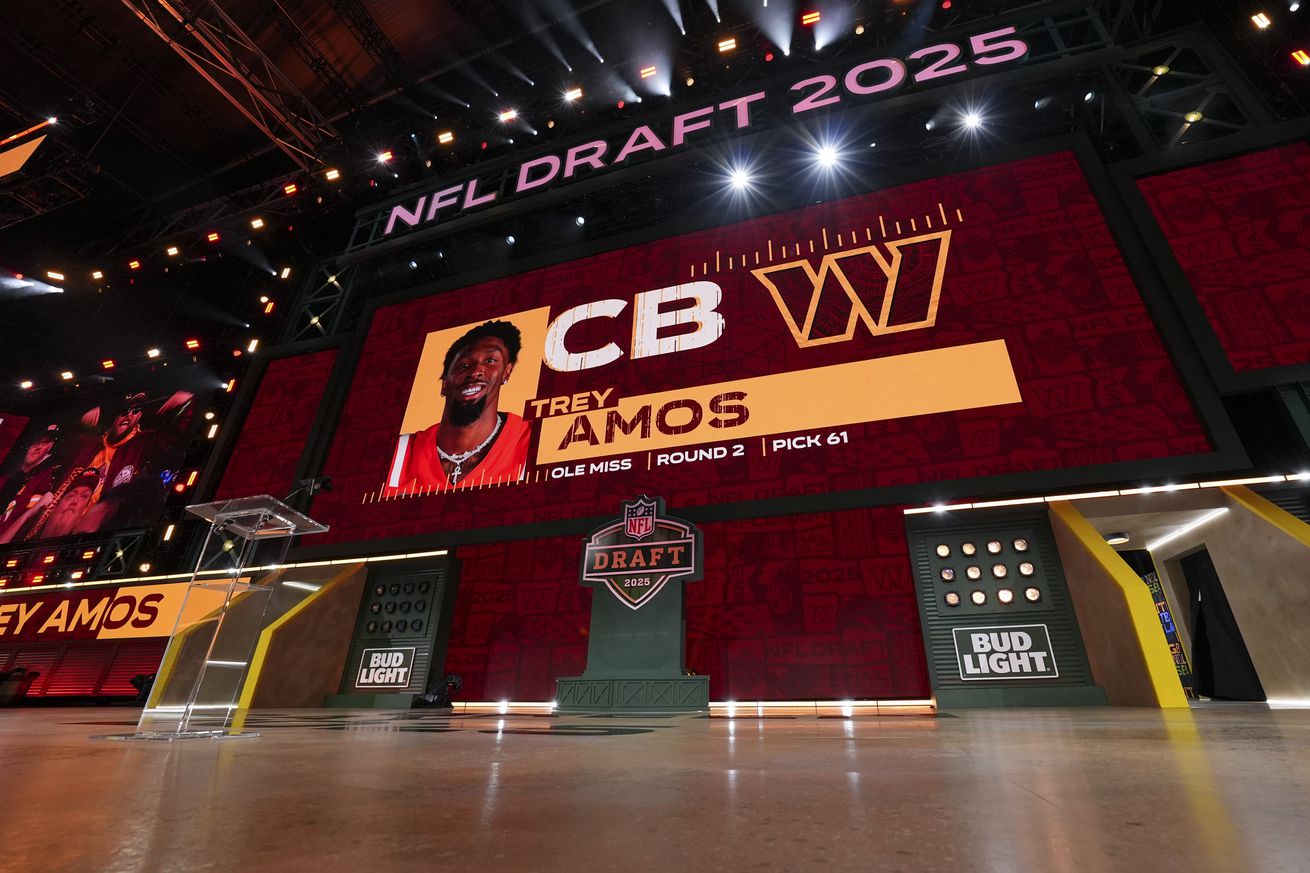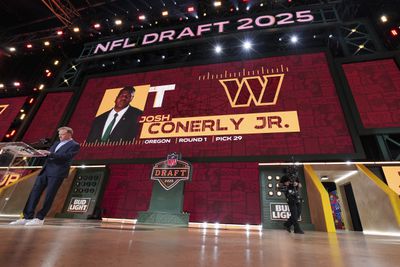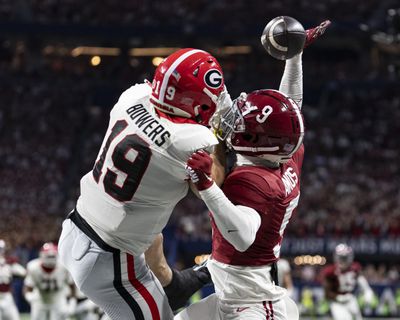
Even more insights into how the Commanders’ new front office thinks about the draft
Last year, newly hired GM Adam Peters took the Commanders’ fanbase by surprise with what struck many as an unorthodox approach in his first draft in Washington. While everyone expected what was coming at the second overall pick – if not the player, the position – that wasn’t the case after the draft got underway.
The Commanders opened the second round by picking a player at the most stacked position on the roster, then traded back with the division rival Eagles to pick an undersized slot corner followed by a TE that media pundits had projected to the fourth round. And the biggest surprise of all was having to wait until the third round, in a stacked offensive tackle class, for the team to pick a player to address what was widely regarded as the most glaring roster hole.
What became apparent, when Peters and Assistant GM Lance Newmark explained the team’s choices, was that the Commanders’ first draft under new management was really a continuation of the approach that Peters and John Lynch had used to build one of the league’s most competitive rosters in San Francisco. After years of wandering the wilderness, the Commanders were finally brought into line with the practices of some of the best drafting teams, from which Peters drew his staff, including the Lions and Ravens.
The abrupt change came as a surprise to fans who had become accustomed to seeing the team telegraph its picks weeks in advance and reach for players at positions of need, while letting elite talents fall to teams picking later, like the Lions and Ravens.
Peters’ philosophy views the draft as the primary mechanism to raise the team’s talent level. He draws on diverse skills of a multidisciplinary team to construct a draft board of players who fit the coaching staff’s requirements and the new team culture. Once the draft is underway, he sticks to the board, picking the best available players and making trades to maximize the return from the team’s draft capital.
The 2025 draft was more of the same, with a few new wrinkles and surprises. In the first part of this two-part recap we saw Peters once again pass up players at the position everyone expected to instead select the highest-rated players on his board who had aced the scouting process with strong support from the coaching staff and analytics department. This time around he passed up trade offers in the first and second rounds because the top rated players on his board were too highly rated to pass up.
While Peters’ selections in the draft prioritized long-term impact over immediate gains, more or less the opposite was true of his use of draft capital to trade for veteran players before the draft.
In the second part, we pick up where the first one left off, with a look at another of Peters’ trades, then revisit his draft priorities and conclude with some new insights about the role of analytics in the team’s player evaluations.
Adam likes to get one back in a trade
The trades for Tunsil and Lattimore shared something in common with last year’s draft trade with the Eagles, recorded here:
Adam Peters negotiating a trade-back with Howie Roseman.
Howie tried to get one over on the first-time GM but Peters wasn’t having it. (Via @Commanders). pic.twitter.com/oC1ioL5CP5
— Grant Paulsen (@granthpaulsen) June 14, 2024
The 2024 draft day trade allowed the Commanders to upgrade from a second- and third-round pick to two second-round picks, while swapping fifth-round picks with the Eagles. Howie Roseman’s initial offer was the Eagles’ 50th and 53rd picks for Washington’s 40th, 78th and 152nd, which represents a 1 point surplus to Washington on the Rich Hill trade value chart. While the deal presumably reflected fair market value, Peters was not happy about losing a draft pick in the exchange:
Hey, I don’t want to lose a pick, so just throw me back 161, I’ll let you set and you’re good.
With the clock winding down, Peters held out until Roseman agreed to throw in the Eagle’s fifth-rounder, which costs just 10 pts on the trade chart.
Trade value charts provide a common currency to establish equivalence between picks at different positions in the draft, with different chances of success, and Peters frequently refers to using them. However, while exchanging three picks for two may represent fair value in terms of the chance of drafting a starter, reducing the team’s number of picks lowers the ceiling on the number of players it can potentially hit on.
Peters appears to be sensitive to this opportunity cost in trades, and has shown a pattern of getting teams to throw in an additional later round pick as a deal sweetener. This strategy, if that’s what it is, goes some way toward mitigating the risks and opportunity costs of his trades.
The Commanders used pick 161 that Peters clawed back from the Eagles last year to draft S/LB Dominique Hampton. It is unclear yet whether the strategy was successful.
In the Tunsil deal, the Commanders got back pick 128 in the fourth round, which was used to draft WR/PR Jaylin Lane.
In the Lattimore deal, the Saints sent 2025 pick 147 back to the Commanders, which was used to acquire Deebo Samuel from the 49ers.
Time will tell if the picks Peters gets back in his trades make a difference. It seems to be a pattern, and it will be interesting to keep an eye on.
Adam just loves offensive tackles

Photo by Perry Knotts/Getty Images
Last year around this time there was a lot of angst expressed over Adam Peters’ alleged failure to adequately address the OT position to protect his rookie QB. Fans were outraged that he didn’t trade back into the first round to pick an OT or sign spent players like David Bakhtiari in free agency. Articles were written about his failure to draft an OT in the late rounds. I even had a heckler posting in all caps under my articles about the new GMs’ lack of love for the position.
Fortunately for Commanders fans and the Daniels family, predictions of Jayden’s premature demise did not come true. Instead, the Commanders’ young signal caller had one of the greatest rookie QB seasons in NFL history, behind a league-average offensive line.
In his first two drafts with the Commanders, Adam Peters has now picked OTs on Days 1 (Josh Conerly) and 2 (Brandon Coleman). That is more investment in the position in the top 75 picks than Dan Snyder’s front offices made in their last five drafts in Washington.
Peters acquired a third OT (Laremy Tunsil) in his costliest trade to date. In terms of total expenditure of draft capital, including trades involving draft picks, OT ranks second at around 420* pts on the Rich Hill chart, after QB at 717 pts.
Although it is still a small sample, early indications suggest that OT is among the GM’s top priorities for draft capital investment. He has yet to draft an interior offensive lineman, although that could change if Brandon Coleman moves to guard. Also, iOL was a major target of investment in free agency along with the extension of Sam Cosmi in the first offseason. Peters’ next lowest draft capital expenditure has been on running back (1 pt), followed by defensive end (3 pts), safety (10 pts) and linebacker (19 pts).
*Calculating expenditure on OT required estimating the value of the 2026 picks traded for Tunsil. To do that I made the conservative assumption that the Commanders would get to the NFC championship round again next season. If they finish worse than expected then OT becomes even more highly valued.
Analytics matter

Photo by Steve Limentani/ISI Photos/Getty Images
One of the biggest changes in the Commanders football operation under Josh Harris and Adam Peters has been bringing analytics to the fore. This is in keeping with both men’s histories with previous teams, and represents a quantum leap from the recent past when Washington was one of two NFL teams without a real analytics department, the other being the Titans.
Peters dropped a few tidbits about how analytics are used in draft evaluations in his comments after Days 1 and 2, and particularly so when discussing the selection of Ole Miss CB Trey Amos in the second round:
I don’t know if you could hear it, but it was probably our R&D Department that was the loudest. He was the top guy on their board coming into the day, and… not by far, but clearly the top guy on our board when we picked. So we were really excited he was there when we picked.
Amos had been ranked so highly that the Commanders would have taken him at 29 if Conerly hadn’t been available, and he was their top target heading into Day 2 of the draft. Peters followed up his initial comments with specific detail about what impressed the analytics team about Amos, which mirrored his comments on Josh Conerly Jr the previous day:
And just some of the things we talked about with Josh yesterday. He was really, really good in our metrics against really good players. So the guys we had rated really high, he was 96th percentile against really good players.
It’s probably unsurprising that teams would be interested in how prospects measure up against the best opponents they faced. But individual matchup data are few and far between in standard stats service offerings.
These comments reveal that the Commanders’ R&D Department generates their own stats on prospects’ performance against other players that they rate highly. This allows the team to evaluate prospects’ performance against the most NFL-ready opponents they faced in college. Peters emphasized in press appearances on Days 1 and 2 that performance against top opponents was weighted highly in the Commanders’ scouting process.
Later in the Day 2 presser he reinforced that message and shared some further detail about specific metrics in which Amos shined:
Q: What did R&D see in him that didn’t show up on tape? What was their perspective?
The one that I mentioned was how he played against the really highly rated players. Also the yards per coverage snap, not giving up a lot of explosives, all of those different metrics. And he was really in the 90th percentile, I don’t have it right in front of me, but five or six different metrics, which really made him in their system a blue player, which is as high as you can get.
I mentioned this comment in my recent Draft Grades, and now I am circling back to do a victory lap.
Around three years ago, I became dissatisfied with the metrics available to evaluate coverage performance. Pass defense metrics (INT, PD, Reception Rate allowed, Passer Rating in coverage) only measure what happens when a defensive back fails to prevent his receiver from being targeted. My search for a metric that correlates with a CB’s ability to shut down receivers eventually led me to Yards per Coverage Snap, which I have been using in articles for Hogs Haven. The most recent of these was my roundup of Ballhawking CBs in the 2025 draft class.
Imagine my surprise to discover that the Commanders’ R&D Department uses the very same metric in their player evaluations.
Amos was one of the standouts in my roundup as a top coverage corner, as well as being an accomplished ballhawk to address Joe Whitt’s frustration with the lack of turnovers. That is a great skillset to add to the Commanders’ defense.
The discovery that I saw something the same way as the Commanders’ scouting operation is a high moment for me in my time writing for Hogs Haven. It makes me glad to learn that I have been providing useful information for HH readers, at least for the last draft cycle.
That’s a Wrap
That’s it for this draft cycle. Over the next few weeks, as we wait for training camp to start, I will be taking a deep dive into a few of the team’s weaknesses in 2024 and what to expect in the 2025 season. But I might take a few days off, first.

